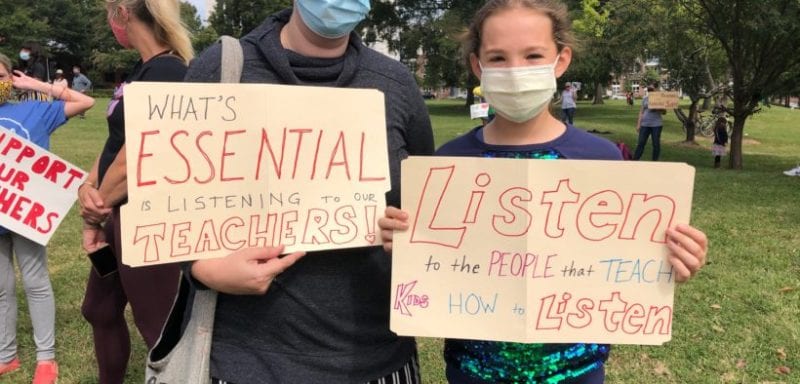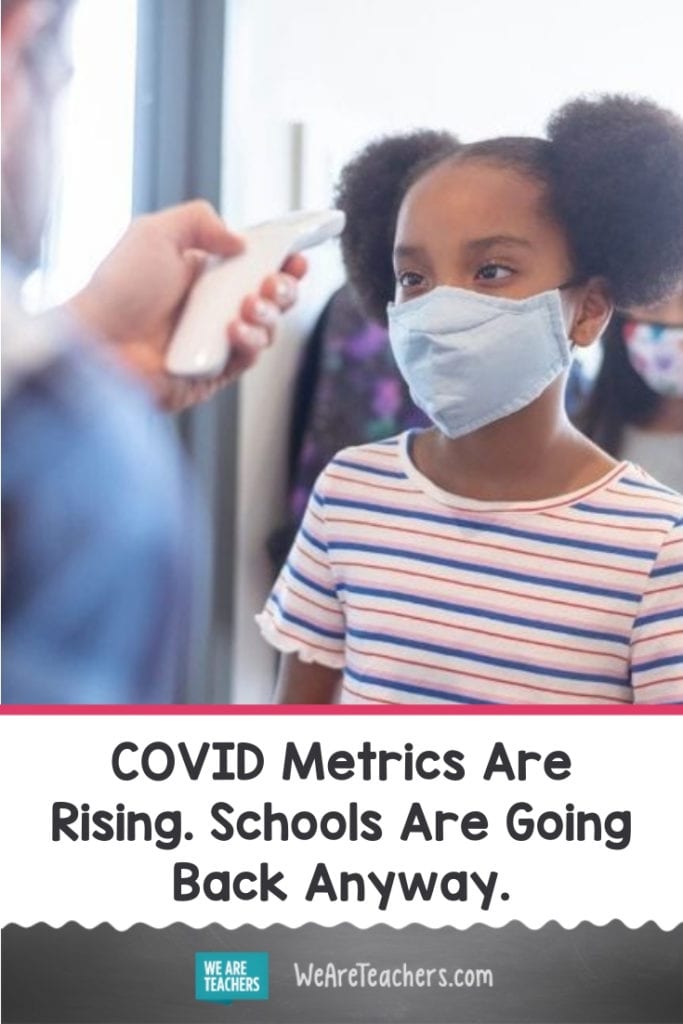In early September, after two weeks of remote learning, five parents in Charlotte, NC sued the district to return to in-person school. The lawsuit sparked debate over when, how, and why the district should transitioning back into buildings.
By the end of September, even with the district in Yellow, the Charlotte school board was moving to bring students back into school buildings.
Charlotte is not the only district that is quickly shifting from remote to in-person instruction, all while 33 states have high enough COVID rates to limit travel, according to the Harvard Global Health Institute risk assessment map.
The questions in Charlotte are kitchen-table fare around the country. When should we head back to school? Who gets to decide? And, where do teachers stand?
When should schools reopen?
It goes without saying that teachers want to be in classrooms, teaching in person, seeing students every day. But, teachers are also aware of the risks of returning to school too soon. In Charlotte, as in other cities, employees at big companies are being told to work from home through 2020, said Amanda Thompson, secondary math coach in Charlotte and middle school representative for the Charlotte Mecklenburg Association. “So why are we rushing it?”
The short answer: we don’t know exactly when school should open.
But, one thing is clear, many districts still have community spread. Health experts have pointed out that most countries that have reopened schools have had one or fewer cases per 100,000 people, while the U.S. has much higher rates, sometimes as high as 60 or 75 cases per 100,000.
[contextly_auto_sidebar]
What happens when schools reopen too soon?
Here’s another case where we don’t really know.
Cases of schools opening in-person with immediate outbreaks made national headlines in August, when schools in Mississippi and Georgia quarantined students within the first week of school. However, re-openings continued throughout September with less fanfare. For example, of nine districts in suburban Illinois that reopened, only some reported COVID cases among staff or students. Butler Elementary District, where 60% of students returned to school, had classrooms divided into taped rectangles to distance students and everyone wearing masks, but, as of late September, had not reported any COVID cases.
In Charlotte, Thompson worries that the district has not fully planned for school safety and too many things are still “in progress.” For example, ensuring that each school had a functioning HVAC system was still in progress in mid-September.
As with many things in education, what happens will be district-by-district. The consequences of reopening depend on each community, which is why teachers and unions are advocating not to reopen until safety can be assured.
So, who wants schools to open?
Often, the pressure to reopen is coming from parents. In Arizona, where most districts are in the “yellow,” parents are demanding that schools reopen, and not in a hybrid model. For example, Gilbert Public Schools, where COVID numbers were increasing slightly in mid-September, moved quickly from a hybrid school opening to fully reopening by September 21, against the state health recommendations.
It’s important to note that many parents support waiting to send kids back until schools are safe. And, there are differences in parent communities that are pushing for school reopenings. Often, it’s more affluent parents who want schools to reopen, compared to parents in lower-income communities, where COVID rates are higher. For example, in Los Angeles, schools in affluent areas are planning sooner openings than those in poor areas.
Where do teachers stand?
Thompson also worries about the burden on teachers as schools in Charlotte move to reopen. She’s not the only one. Concerns over returning to school have prompted teachers to make their voices heard. In Orange County, CA, teachers have petitioned and protested to postpone reopening. Teachers joined parents to protest reopening plans in Decatur, GA as well.

Image from: https://decaturish.com/2020/09/teachers-and-parents-protest-outside-city-schools-of-decatur/
The decisions to return to school, may make teachers feel like they are on the sidelines. “Teachers feel as if they don’t matter,” said Thompson. “In March we were superheroes, now we’re being forced into a situation where we don’t have a choice.”
What are you seeing in your community? What do you think of your school’s reopening plan? Come and share in our WeAreTeachers HELPLINE group on Facebook.
Plus, what it’s really like to teach in-person and online at the same time.

